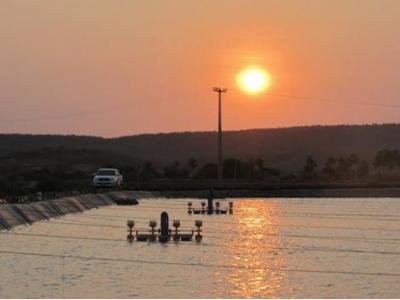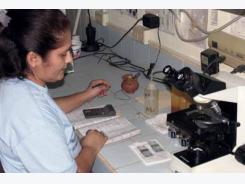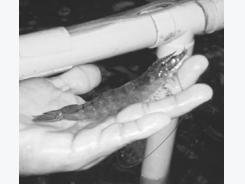The importance of dissolved oxygen in Pacific White Shrimp Culture

At present, industrial scale marine shrimp producers in almost every country produce the same kind of shrimp-- Pacific White Shrimp, or White Leg Shrimp. Production of Black Tiger Shrimp is dropping every year in proportion to the increase in Pacific White Shrimp production. The main countries that still produce significant amounts of BlackTiger Shrimp are Bangladesh, Vietnam, India and the Philippines. Other than that, all the leading shrimp producing countries, such as Thailand, China and Indonesia, produce almost exclusively Pacific White Shrimp. In Vietnam and Indonesia production of Pacific White Shrimp is also rising every year while production of Black Tiger Shrimp is dropping. The main reason for the popularity of this variety is that long years of genetically breeding have resulted in a variety that is easy to raise, even in intensive conditions, grows quickly and has consistent size. By contrast, Black Tiger Shrimp culture produces inconsistent results, even though it is now possible to obtain breeding shrimp domesticated brooders rather than from the wild. The economic performance of Black Tiger Shrimp cannot compare with Pacific White Shrimp.
Almost every country produces the same kind of shrimp and for the same objective—export sales. The only exception is Brazil, which Pacific white shrimp mainly for domestic consumption, because the price is quite high. China also produces significant amounts of shrimp for the domestic market. In the future it is likely that China will have to import more shrimp due to the high rate of economic expansion in China. By comparison, most of the world’s other major economic powers, such as the USA, the EU and Japan, are all experiencing economic downturns. It will probably take a long time before their economies grow strong again. These countries are the major purchasers of imported shrimp. It is unlikely that there will be a strong increase in demand for shrimp and that prices will rise in the near future, unless there are some unexpected problems, such as disease outbreaks or extreme weather, in some of the major shrimp producing countries, leading to reduced supply of shrimp in the world market. For now, shrimp producers need to find ways to insure that their yield is certain, within the capacity of their production system, and that they can control production costs to remain competitive.
It is well known that feed costs attribute 40-50% of the total costs of shrimp production. Thus, efforts at cost reduction often focus on controlling the amount of feed given to the shrimp so that there is no excess or unnecessary waste. Proper feed management will maintain the good water quality in the cultured ponds leading to a successful yield. However, good food management is not the only factor required to insure that the shrimp grow well. If the amount of dissolved oxygen (DO) in the pond is too low, the shrimp will eat less and there will be more left over food. This will affect other parameters of water quality, and if the water quality drops the shrimp will get weak and more susceptible to bacterial infection. Such conditions lead to low survival rates. When the DO of the water is low, the shrimp’s growth rate is slow and the feed conversion ratio (FCR) is very high. It takes longer to raise a batch of shrimp than when the DO is sufficient. You can see that in 2010-2011 there were many more problems with bacterial diseases than before. In the past, bacterial infection was seldom a problem with Pacific White Shrimp culture. This indicates that there is something wrong or something lacking with the aquaculture management practices used at present. Usually it is a problem with overfeeding. Excess feed causes a build up of waste materials in the pond, which encourages the growth of disease-causing Vibrio bacteria. When the oxygen or DO level in the pond drops over the course of the culture period, the shrimp are likely to get sick.
The most appropriate DO for shrimp health and normal growth is from no less than 4 mg/l (ppm) up to the saturation point. The amount of oxygen that can remain dissolved in the water depends on the water temperature. When the temperature is higher, the water can hold less oxygen. For shrimp culture it is best to maintain the DO at 6-8 mg/l, or no less than 4 mg/l all the time. In reality, on most farms the DO only stays this high during the first month or two of the culture period. On some farms, once the shrimp are 30 days old the night time DO, from about midnight to early morning before dawn, goes down to less than 3 ppm. This situation is found on extensive culture farms with no aerators and on semi-intensive culture farms or sometimes on intensive farms or sometimes on intensive farms.
Extensive farms
Almost all the Latin American countries use an extensive culture system. The pond size is very large, from 3 up to 100 hectares, but most are about 10-20 hectares. The ponds are normally quite shallow, just 1.0 to 1.20 meters, and the water is changed frequently, almost every day or every other day. This is because the pond bottoms are rather porous. The pond preparation procedure is to dry out the pond after shrimp is harvested, plough the pond bottom, and add some lime before refilling the pond with water. The water that is pumped in is passed through a filter to prevent out unwanted organisms. The shrimp are released into the ponds after they have been raised in a race way nursery for 2 weeks. The population density varies, but the average is 10-20 shrimp per square meter. It is interesting to note that in almost every Latin American country, the shrimp feed is always placed only in feed trays. The ponds may have about 30 feed trays or more per hectare. Feeding and checking the trays for leftover feed is thus a very time-consuming procedure. It takes a long time for the workers to row over to every feed tray to feed the shrimp. Most of the farms feed the shrimp just once a day and a few feed them twice a day, morning and evening. Very few farms, such as those in Honduras, use a broadcast feeding method like that used in most Asian countries and have only a few feed trays.
The disadvantage of using feed trays exclusively, besides the long time it takes to feed the shrimp, is that large numbers of shrimp have to compete for feed in a small area. This causes much of the feed to be spilled out over the sides of the trays and fall underneath the trays, which are close to the bottom of the pond. As the shrimp try to get at the feed underneath the trays, it creates a hollowed out basin under each trays that gets larger and deeper as the shrimp get larger. These basins soon fill with sediment and any new feed that falls down gets mixed into the sediment and wasted. It is difficult to accurately determine how much the shrimp are eating because it takes so long to fill and check all the trays. Some may be empty while others may have a large amount of feed left. This feeding system leads to slow growth and the FCR is generally higher than for broadcast feeding systems. For a broadcast feeding system, the feed is distributed around the clean area in the pond and there are only about 4 feed trays per hectare, or even less for very large ponds. For instance, a 25-hectare pond might have only 25 feed trays.
Semi-intensive farms
On the semi-intensive farms in Latin American countries, the population density is higher at about 20-60 shrimp per square meter. The ponds are also 1.0-1.20 meters deep and they have some aerators, but not many; on average about 6-18 hp/hectare. The ponds are smaller, just 1-3 hectares each on most farms or up to 10-20 hectares on some farms. With only a few aerators, it is not possible to sweep all the sediment and waste to the center of the pond as is done in Thailand. Most of the farms have the aerators positioned so that the water flows from the water inlet on one side of the pond to the water outlet on the opposite side. In this system, large amounts of sediment tend to accumulate in the wide areas between each aerator. The same as with extensive culture farms, almost all the semi-intensive farms in Latin America place the shrimp feed only in feed trays. Some of the farms use a broadcast feeding method with few feed trays, but since they have only a few aerators they have problems with the shrimps’ growth rate slowing after they reach about 50 days old. This is because the dissolved oxygen level drops greatly at night. At the same time, sediment and organic material accumulates at the bottom of the pond. When the shrimp grow slowly, they are weaker and the survival rate will be lower. The FCR is usually very high.
Intensive Farms
On the intensive shrimp farms in Thailand, most farmers install at least 36 hp of aerators per hectare to be sure that there will be enough water current to keep the bottom of the pond clean in the feeding areas. The sediment is all swept towards the center of the pond. Naturally, the aerators also help raise the amount of dissolved oxygen in the water so that organic material will be decomposed by microorganisms more efficiently. The DO should not drop below 4 ppm, even in the pre-dawn hours. If they wish to produce large biomass of shrimp, most farms use even more aerators, based on the general rule that you can produce about 450 kg of shrimp for every 1 hp of electric motor aerator. This applies for a farm management system where the water is not changed often but feeding is managed properely. If the farmer notices that the DO has dropped below 4 ppm in the morning or the shrimp seem to be growing more slowly than normal, most farmers will make a partial harvest to reduce the number of shrimp in the pond, so it is not necessary to use as much feed for the remainder of the culture period. Adding high volumes of feed to the pond every day has an effect on the oxygen level and water quality. Farms that are successful in keeping the DO at no less than 4 ppm even in the morning are usually very successful, with good growth rates, a high survival rate and a low FCR. When the DO is maintained at at least 4 ppm, there is seldom a problem with white feces disease or bacterial infections. In contrast, on farms where the DO drops below 4 ppm at night, the shrimp will grow slowly during the culture period and white feces disease is very common.
Once large numbers of shrimp are infected with bacterial diseases it is usually not possible to treat them. Usually the farmer has to harvest them early, around 70-90 days, which means the production target is not met and the FCR is quite high. Researchers at the Aquaculture Business Research Center (ABRC) did an experiment in which shrimp weighing 7 g each were kept in aquariums filled with water at the salinity level of 25 ppt and kept at 29+ 1 oC, which is the optimum temperature for shrimp growth. The shrimp were divided into 3 groups, with 3 aquariums for each group, as follows:
Group 1: DO was kept at over 4 ppm all the time
Group 2: DO was kept at 2-4 ppm
Group 3: DO was slightly less than 2 ppm
The shrimp were fed 3 times a day, with each feeding spaced 4 hours apart. At each feeding they were given 1.1% of their body weight in pellet feed, since 10-g shrimp should be fed 3.3% of their body weight per day (Limsuwan and Chanratchakool, 2004). The researchers counted the number of feed pellets given to the shrimp and the amount remaining in the aquarium 15, 30, 45 and 60 minutes after feeding. The results are shown in Table 1.
Table 1 Feed intake of L. vannamei at three different dissolved oxygen concentrations
| Dissolved oxygen % leftover feed (min) | ||||
| (ppm) | 15 | 30 | 45 | 60 |
| < 4 | 21.03 + 5.43a | 2.60 + 3.31a | 0 + 0.00a | 0 + 0.00a |
| 2-4 | 56.10 + 6.03b | 13.22 + 5.67b | 0 + 0.00a | 0 + 0.00a |
| < 2 | 84.28 + 6.00c | 73.31 + 3.65c | 59.27 + 5.04b | 45.27 +7.80b |
Average values with different letters in the same row are statistically significantly different (P<0.05)
From Table 1 you can see that the shrimp that were in well oxygenated water (DO over 4 ppm) ate the feed very quickly, with only 21.03% left after just 15 minutes. They ate all of the feed within 45 minutes. The group of shrimp in water with DO 2-4 ppm ate more slowly, but still finished all the feed within 45 minutes. The shrimp that were in water with DO of less than 2 ppm ate very little and after 45 minutes, 59.27 % of the feed was still left. Some of them tried to eat feed while it was near the surface of the water, where the oxygen level is higher. In experimental conditions in the laboratory, excess feed that falls to the bottom of the aquarium will be sucked up by the water filter system, but in real farm conditions the left over feed remains in the pond and causes the water quality to drop. Ammonia and organic matter build up in the water and the amount of Vibriobacteria rise. This has a bad effect on shrimp health. When the shrimp are weakened by low oxygen conditions, they tend to have problems molting and many will die while molting or just after molting.
On most shrimp farms, during the day time the DO level is suitable at over 4 ppm. On sunny days, the phytoplankton in the water photosynthesize and give off oxygen. On farms with large populations of phytoplankton in the water, the DO may rise to over 10 ppm in the afternoon. This is often the case on intensive farms with low salinity and good plankton bloom, where the aerators are turned off during the day when it is sunny. However, even on farms where the day time DO is quite high, after about 21:00 at night the oxygen level starts to drop because of the respiration of the plankton, the shrimp and the micro organisms that are decomposing organic matter. The DO drops to very low from about midnight to early morning. In the pre-dawn hours the DO may be down to 3-4 ppm, 2-3 ppm or even less than 2 ppm on some farms. This is also the case on extensive farms with no aerators and low density of shrimp, and on semi-intensive farms with 30-60 shrimp per square meter and about 6-18 hp per hectare of aeration. The DO usually drops to about 2-3 ppm at night, or even lower at times. The shrimp grow slowly, the survival rate is low and the FCR is high. The shrimp grow better on farms where the oxygen level is higher.
Another experiment demonstrated that in addition to influencing shrimp feeding behavior, DO also has an effect on shrimp growth, survival rate and FCR. For this experiment, White Pacific Shrimp with an average weight of 7.6 g each were kept in 500-liter fiberglass tanks filled with water with salinity of 25 ppt and maintained at a constant water temperature of 29+1oC. There were 30 shrimp per tank, or a population density of 54 shrimp per square meter. Under farm conditions, shrimp normally exhibit problems of slow growth due to low DO after 50-60 days. For the experiment, the shrimp were randomly divided into 3 groups, with 3 replications for each group:
Group 1: DO was kept at over 4 ppm all the time
Group 2: DO was kept at over 4 ppm for 12 hours and at 2-4 ppm for 12 hours (from 18:00- 06:00)
Group 3: DO was kept at over 4 ppm for 12 hours and at less than 2 ppm for 12 hours (from 18:00- 06:00)
The shrimp were fed 3 times a day at 8:00, 12:00 and 16:00.
After 60 days the survival rate, growth rate, average weight, yield and FCR were the most favorable in the group that was kept in water with DO of over 4 ppm all the time, and were less favorable in Group 2 and Group 3, in that order, as you can see from Tables 2 and 3. These results clearly confirm that DO is an important factor for achieving the desired results in shrimp culture. In addition, hematology and immune response tests on the haemolymph of shrimp from this experiment also showed that the total haemocyte count was higher in the group that was kept in water with high DO (Table 4). Other immune parameters were also higher in the group that was kept in water with high DO. For more details see “Effects of Dissolved Oxygen Levels on Growth, Survival, Non-Specific Immune Characteristic of Pacific White Shrimp Litopenaeus vannamei and Challenged with Vibrio harveyi” (Nonwachai et al., 2011).
Table 2 Average body weight of L. vannamei under three different DO levels
| Day | Average body weight (g) | ||
| Treatments | |||
| A (DO>4 ppm) | B (DO 2-4 ppm) | C (DO<2 ppm) | |
| 0 | 7.67 + 0.47a | 7.62 + 0.45a | 7.68 + 0.35a |
| 10 | 10.40 + 0.56a | 9.54+0.54b | 8.91 + 1.07c |
| 20 | 12.8 + 1.03a | 11.74 + 0.59b | 11.05 + 1.42c |
| 30 | 16.00 + 1.38a | 15.64 + 1.79a | 14.32 +1.81b |
| 40 | 18.94 + 1.27a | 18.12 + 0.81a | 17.22 + 2.96b |
| 50 | 25.26 + 2.27a | 23.13 + 2.55b | 23.01 + 2.72b |
| 60 | 28.16 + 2.77a | 25.01 +1.81b | 25.90 + 2.51b |
Average values with different letters in the same row are statistically significantly different (P<0.05)
Table 3 Percentage survival of L. vannamei under three different DO levels
| Day | Percentage survival | ||
| Treatments | |||
| A (DO>4 ppm) | B (DO 2-4 ppm) | C (DO<2 ppm) | |
| 0 | 100.00 + 0.00a | 100.00 + 0.00a | 100.00 + 0.00a |
| 10 | 100.00 + 0.00a | 97.78 + 1.92a | 84.44 + 3.85b |
| 20 | 97.78 + 1.92a | 93.33 + 3.33a | 76.67 + 5.77b |
| 30 | 97.78 + 1.92a | 90.00 + 6.67a | 65.56 + 10.18b |
| 40 | 93.33 + 3.33a | 84.44 + 12.62a | 65.56 + 5.09b |
| 50 | 93.33 + 3.33a | 81.11 + 13.47a | 60.00 + 8.82b |
| 60 | 92.22 + 3.85a | 81.11 + 13.47a | 56.67 + 8.82b |
Average values with different letters in the same row are statistically significantly different (P<0.05)
Table 4 Total haemocyte count (THC) of L. vannamei under three different DO levels
| Day | THC (x 105 cells/ml) | ||
| Treatments | |||
| A (DO>4 ppm) | B (DO 2-4 ppm) | C (DO<2 ppm) | |
| 0 | 123.67 + 5.97a | 120.08 + 8.50a | 121.80 + 7.47a |
| 10 | 140.78 + 8.56a | 138.59 + 6.03a | 132.66 + 5.65b |
| 20 | 148.75 + 8.54a | 146.17 + 5.97a | 138.91 + 7.80b |
| 30 | 163.13 + 6.97a | 161.02 + 8.75a | 139.45 + 8.25b |
| 40 | 178.75 + 8.54a | 176.17 + 5.97a | 146.17 + 5.97b |
| 50 | 185.63 + 5.27a | 183.52 + 8.75a | 163.13 + 6.97b |
| 60 | 200.63 + 5.85a | 198.67 + 5.97a | 161.17 + 5.97b |
Average values with different letters in the same row are statistically significantly different (P<0.05)
In order to meet their goals in the production of Pacific White Shrimp, besides paying attention to the quality of the shrimp postlarvae, the suitable season of the year, and using recommended farm management practices, farmers should also pay close attention to maintaining the DO level in the water at all times. It is more profitable to concentrate on keeping the oxygen level high rather than applying various chemicals or other products to try to solve problems as they occur. If the DO is at a suitable level all the time, the shrimp will grow well and remain healthy. There will be practically no need to worry about parasites and bacterial infections.
Author:
Chalor Limsuwan, Ph.D.
Aquaculture Business Research Center (ABRC)
Faculty of Fisheries, Kasetsart University, Thailand
Related news
Tools

Phối trộn thức ăn chăn nuôi

Pha dung dịch thủy canh

Định mức cho tôm ăn

Phối trộn phân bón NPK

Xác định tỷ lệ tôm sống

Chuyển đổi đơn vị phân bón

Xác định công suất sục khí

Chuyển đổi đơn vị tôm

Tính diện tích nhà kính

Tính thể tích ao




 Ongoing Studies Advance Intensive Shrimp Culture In Zero-Exchange…
Ongoing Studies Advance Intensive Shrimp Culture In Zero-Exchange…  Whitespot resistant gene could save shrimp industry millions
Whitespot resistant gene could save shrimp industry millions